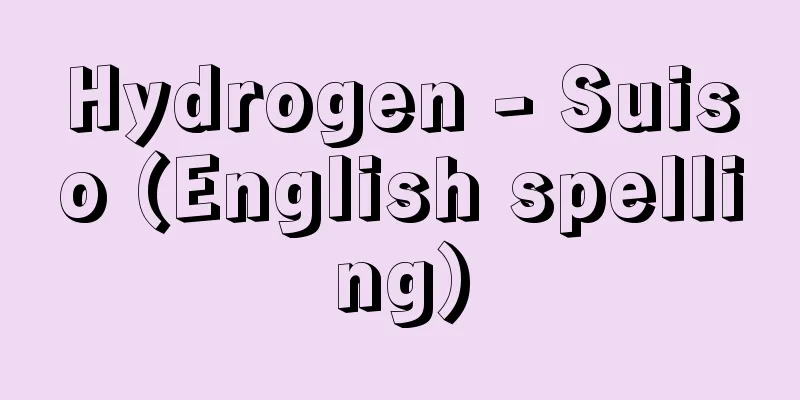Hydrogen - Suiso (English spelling)

|
It is the first element in the first period of the periodic table. It is similar to the elements in groups 1 and 17, and in the short-period periodic table, it is either placed in both groups I and VII, or, due to its uniqueness, it is treated as an independent element without being included in either group. It has isotopes with mass numbers 2 and 3 (deuterium), but unlike other elements, the mass difference is significant, being two or three times that of an ordinary hydrogen atom (called light hydrogen or protium compared to deuterium), and the properties are also very different. Therefore, hydrogen with mass number 2 is called deuterium or deuterium (D or 2 H), and hydrogen with mass number 3 is called tritium or tritium (T or 3 H). [Kenichi Morinaga and Katsunori Nakahara] historyIn 1766, Cavendish of England identified deuterium as a flammable gas obtained from acids and metals. Following the phlogiston theory that was believed at the time, he initially considered this light gas to be phlogiston, but after he confirmed that this gas only produced water when burned in 1781, he came to believe that it was a compound of water and phlogiston. It was Lavoisier of France who correctly recognized it as an element. In 1783, he decomposed water by passing steam through a red-hot iron tube, and demonstrated that water is not an element. He also stated that the gas obtained was an element, and named it "hydrogène" (French name: hydrogen). In Greek, "hydro" means water, and "gennao" means to make. The element symbol H is the initial letter of the Latin name hydrogenium. In 1933, H. C. Urey of the United States and others discovered deuterium by repeatedly electrolyzing water. In the following year, 1934, Marcus Laurence Elwin Oliphant (1901-2000) and his team produced tritium for the first time by bombarding a deuterium compound with deuterium. Tritium was detected in the atmosphere in 1950. [Kenichi Morinaga and Katsunori Nakahara] ExistenceHydrogen is the most abundant element in the universe. It is the lightest of all substances, and therefore it is concentrated in the upper atmosphere of the Earth and very little in the lower atmosphere, with dry air containing only about 5×10 -5 % by volume of hydrogen. Elemental hydrogen is found in volcanic gas and natural gas, but on the Earth's surface it is combined with oxygen in the form of water and is widely present throughout the lithosphere (crystal water, etc.), hydrosphere (seawater, continental ice, etc.), atmosphere, and biosphere. Hydrogen also exists in various stars and in interstellar matter, and is widely distributed throughout space, accounting for about 93% of the total number of atoms in the universe. Hydrogen is also the starting material for all other elements. [Kenichi Morinaga and Katsunori Nakahara] Manufacturing methodIn industrial applications, synthetic gas (a mixture of carbon monoxide and hydrogen) is produced by reacting petroleum, coal, natural gas, etc. with oxygen, air, or steam at high temperatures, from which hydrogen is extracted. Other methods include separation from water gas obtained by passing steam through carbon heated to over 1000°C, pyrolysis of hydrocarbons, and electrolysis of salt water. In laboratories, hydrogen is produced by reacting zinc with dilute hydrochloric acid or dilute sulfuric acid, or by electrolyzing an aqueous solution of an alkali hydroxide or sulfuric acid. Relatively pure hydrogen can be obtained easily by electrolysis, but methods using zinc and acid are prone to contain impurities (arsine, phosphine, hydrogen sulfide, hydrocarbons, etc.). The hydrogen contained in commercially available red cylinders is usually 99.5% pure or more, and can be used as is for normal purposes. Deuterium is produced industrially by electrolyzing heavy water. [Kenichi Morinaga and Katsunori Nakahara] structureThe hydrogen atom is the simplest atom, consisting of a nucleus (one proton) and one electron. Deuterium has one neutron in its nucleus, while tritium has two neutrons. They differ somewhat in their physical properties, such as boiling point and melting point, as well as in their chemical reactivity. Tritium is radioactive and decays naturally by releasing an electron. [Kenichi Morinaga and Katsunori Nakahara] natureHydrogen is a colorless, tasteless, and odorless gas at room temperature. It always exists as a diatomic molecule , H2 . However, at the moment of hydrogen's activation (so-called nascent hydrogen) at the moment of its generation through chemical reactions or electrolysis, or in a low-pressure hydrogen discharge tube, it exists as atomic hydrogen. The two atomic nuclei (protons) of a hydrogen molecule each rotate on their own axis, so there are two isomers: ortho-hydrogen, which rotates in the same direction, and para-hydrogen, which rotates in the opposite direction. At room temperature, hydrogen is a mixture of 75% ortho-hydrogen and 25% para-hydrogen, and the proportion of para-hydrogen increases as the temperature is lowered (for example, -193.1°C: 48.35%, -253.1°C: 99.8%). Hydrogen molecules have the smallest molecular weight, making them the lightest of all gases, and their molecular speed at the same temperature is the fastest of all gases. For this reason, their thermal conductivity is about seven times that of air, making them excellent cooling agents. At room temperature, they are not very reactive, and only fluorine will combine directly with them. They will combine explosively with chlorine under the action of light. A 1:1 mixture is called a chlorine detonation gas. However, at high temperatures, they become active and combine with many metals and nonmetallic elements to form hydrides. Some metals absorb hydrogen when its partial pressure is high, and release it again when the partial pressure is low (e.g., palladium, nickel, etc.). A mixture of hydrogen and oxygen is stable at room temperature, but when heated to above 550°C, or in the presence of a spark or flame, or a suitable catalyst, it will react with a large amount of heat and produce water. In particular, a 2:1 mixture is called a detonation gas, and explodes most violently. In air or oxygen, it will burn with a flame and produce water. When heated with a metal oxide, it will reduce to produce the metal. In addition, in the presence of a catalyst, reactions such as hydrogenation (hydrogen addition) occur with unsaturated organic compounds. [Kenichi Morinaga and Katsunori Nakahara] ApplicationsLiquid hydrogen is used in ammonia synthesis, various hydrogenation reactions related to the petrochemical industry (cracking, isomerization, desulfurization, etc.), hydrogenation of fats and oils, production of hydrogen chloride and catalysts, fuel cells, and as an oxyhydrogen flame (approximately 2500°C) for welding and cutting metals, and as a coolant for low-temperature experiments. Of these, the use that has attracted the most attention in recent years is as an energy source. Hydrogen is used in fuel cells and other applications because it turns into water when burned and does not cause environmental pollution. Liquid hydrogen is also used as a coolant for low-temperature experiments. [Kenichi Morinaga and Katsunori Nakahara] [References] | | | [Supplementary information] |©Shogakukan "> Periodic Table ©Shogakukan "> Hydrogen isotopes Source: Shogakukan Encyclopedia Nipponica About Encyclopedia Nipponica Information | Legend |
|
周期表中第1周期、第1番元素である。第1族および第17族に属する元素に似たところがあり、短周期型周期表ではⅠ族およびⅦ族の両方に属させるか、あるいはその特異性を重視して、いずれの族にも含めず、独立した扱いをとることがある。同位体として質量数2および3のもの(重水素)が存在するが、ほかの元素の場合と異なり、普通の水素原子(重水素に対し軽水素、プロチウムという)の2倍、3倍というように質量の差が甚だしく、その性質の違いも大きい。それゆえ、質量数2の水素を重水素あるいはジュウテリウム(Dまたは2H)、質量数3の水素を三重水素あるいはトリチウム(Tまたは3H)とよぶ。 [守永健一・中原勝儼] 歴史1766年、イギリスのキャベンディッシュにより、酸と金属から得られる可燃性の気体として確認された。当時信じられていたフロギストン説に従って、彼は初めこの軽い気体をフロギストンと考えたが、1781年にこの気体が燃えて水のみを生じることを自分で確かめてからは、このものが水とフロギストンとの化合物であると考えるようになった。これを正しく元素として認識したのはフランスのラボアジエであった。すなわち、1783年、灼熱(しゃくねつ)した鉄管中に水蒸気を通して水を分解し、水が元素ではないことを明らかにするとともに、得られた気体が元素であるとして、この気体に「水の素」(フランス名hydrogène)と名づけた。ギリシア語でhydroは水、gennaoはつくるの意味である。元素記号Hはラテン名hydrogeniumの頭文字である。アメリカのH・C・ユーリーらは1933年、水の電解を繰り返して重水素を発見した。また翌1934年オリファントMarcus Laurence Elwin Oliphant(1901―2000)らは、重水素化合物にジュウテロンを衝撃させて初めてトリチウムをつくった。1950年には大気中にトリチウムが検出された。 [守永健一・中原勝儼] 存在宇宙全体では水素はもっとも多量に存在する。単体は全物質中もっとも軽く、したがって地球の上層大気には多く集まり下層部分ではきわめて少なく、乾燥空気は約5×10-5容量%の水素を含むだけである。単体水素は火山の噴気、天然ガス中などに存在するが、地球表面では酸素と化合した水の形で、岩石圏(結晶水など)、水圏(海水、大陸氷など)、気圏および生物圏にわたって広く存在している。水素は各種の星、あるいは星間物質としても存在し、宇宙空間に広く分布し、宇宙全体の総原子数の約93%を占める。また、水素は他のすべての元素の出発物質でもある。 [守永健一・中原勝儼] 製法工業的には、石油、石炭、天然ガスなどを酸素または空気、水蒸気などと高温で反応させて合成ガス(一酸化炭素と水素の混合物)をつくり、これから水素を取り出す。そのほか、1000℃以上に熱した炭素に水蒸気を通して得られる水性ガスからの分離、炭化水素の熱分解、塩水の電気分解などが利用される。実験室では、亜鉛に希塩酸または希硫酸を反応させてつくるか、水酸化アルカリまたは硫酸の水溶液を電気分解してつくる。電解法では比較的純粋な水素が得られやすいが、亜鉛と酸を用いる方法では不純物(アルシン、ホスフィン、硫化水素、炭化水素など)が含まれやすい。市販の赤色ボンベに入っている水素は、普通99.5%以上の純度があり、通常の目的にはそのまま使用して差し支えない。重水素は重水を電気分解して工業的につくられている。 [守永健一・中原勝儼] 構造水素原子はもっとも簡単な原子で、原子核(陽子1個)と電子1個からなる。ジュウテリウムは原子核に中性子1個、トリチウムは2個の中性子をもつ。これらは沸点、融点などの物理的性質だけでなく、化学的反応性にもいくぶんか差がみられる。トリチウムは放射性で、電子を放出して自然に崩壊する。 [守永健一・中原勝儼] 性質水素は常温で無色、無味、無臭の気体。つねに二原子分子H2として存在する。ただし化学反応や電気分解などによって発生する瞬間の水素の活性状態(いわゆる発生期の水素)や水素の低圧放電管内では原子状水素として存在する。水素分子の2個の原子核(陽子)はそれぞれ自転しているので、自転の方向が同じであるオルト水素と、反対であるパラ水素という異性体がある。常温では、オルト水素75%とパラ水素25%の混合物であり、温度を下げていくとパラ水素の割合が増えていく(たとえば-193.1℃:48.35%、-253.1℃:99.8%)。 水素分子は分子量がもっとも小さく、そのためすべての気体のなかでもっとも軽く、同じ温度での分子速度は、すべての気体のなかでいちばん大きい。このため熱伝導率も空気の約7倍と大きく、冷却効果が優れている。常温では反応性に乏しく、直接化合するのはフッ素だけである。塩素とは光の作用のもとに爆発的に化合する。1:1混合物は塩素爆鳴気とよばれている。しかし、高温では活性となり、多くの金属、非金属元素と化合して水素化物をつくる。金属によっては、水素の分圧が高いとき吸収し、低くなるとふたたび放出するものがある(たとえばパラジウム、ニッケルなど)。水素と酸素との混合物は常温では安定であるが、550℃以上に熱するか、火花あるいは炎など、また適当な触媒の存在で、多量の熱を発して反応し水を生成する。とくに2:1混合物は爆鳴気とよばれ、もっとも激しく爆発する。空気中あるいは酸素中では炎をあげて燃え、水を生成する。金属酸化物と熱すると還元して金属を生じる。また、触媒があると、不飽和有機化合物と水素化(水素添加)などの反応をおこす。 [守永健一・中原勝儼] 用途アンモニア合成、石油化学工業に関連した各種の水素化反応(分解、異性化、脱硫など)、油脂の水素添加、塩化水素や触媒などの製造、燃料電池、酸水素炎(約2500℃)として金属の溶接・切断などに、液体水素は低温実験用の冷却剤として用いられる。これらのなかで近年もっとも注目されるのは、エネルギーとしての用途である。水素は、燃えれば水となり環境汚染を生じないことから燃料電池その他に用いられる。また液体水素は低温実験用の冷却剤として用いられる。 [守永健一・中原勝儼] [参照項目] | | | [補完資料] |©Shogakukan"> 周期表 ©Shogakukan"> 水素の同位体 出典 小学館 日本大百科全書(ニッポニカ)日本大百科全書(ニッポニカ)について 情報 | 凡例 |
>>: Narcissus bulb fly (Lampetia equestris; narcissus bulb fly)
Recommend
Ano-dachi Pond - Ano-dachi
A Buddhist term. A pond where Anutta Dragon King l...
Perim
...The western coast is bordered by Eritrea and D...
Gunung Tambora (English spelling)
A stratovolcano with a basal diameter of about 40 ...
Women's studies
A field of study that reexamines existing male-do...
Dendrobium nobile (English spelling)
…[Koichi Ejiri]. … *Some of the terminology that ...
Workers' Accident Compensation - Workers' Accident Compensation
Compensation received by injured workers or surviv...
Gulf of Gascogne
Please see the "Bay of Biscay" page. So...
Forgery of documents - bunshogizozai
It is a crime to forge or alter documents, create...
Ishikawa Eisaku
…Published in 1776. In Japan, since the publicati...
Kisaburo Yokota
International law scholar. Born August 6, 1896 in...
Yoshimizu Shrine
Located in Yoshino-cho, Yoshino-gun, Nara Prefect...
Diomedea albatrus (English spelling)
…[Hiroshi Aramata]. … *Some of the terminology th...
Hodge, Charles
Born: December 27, 1797, Philadelphia [died] June ...
Entering the sea - Umiiri
...In coastal fishing or coastal fishing, when pe...
What is meant - What is meant
…The functions of these similarity associations a...









